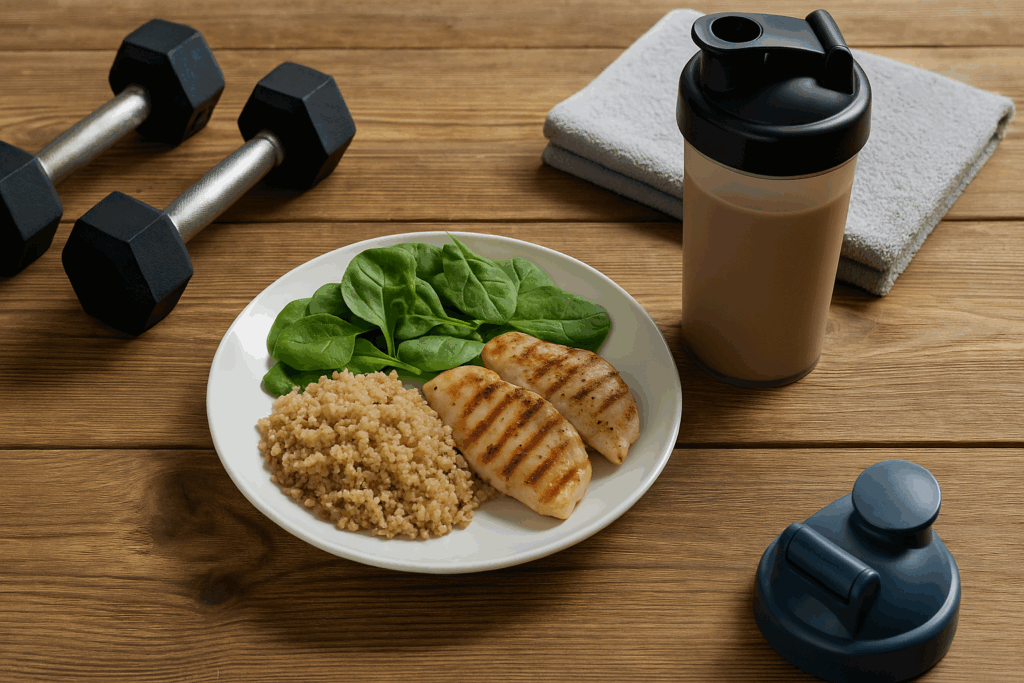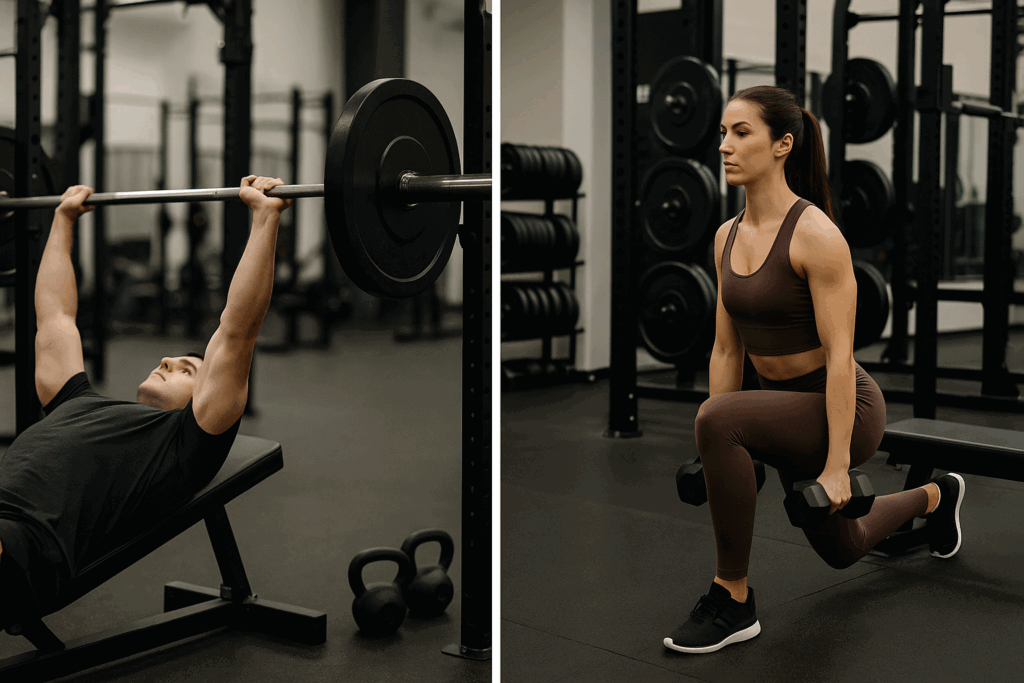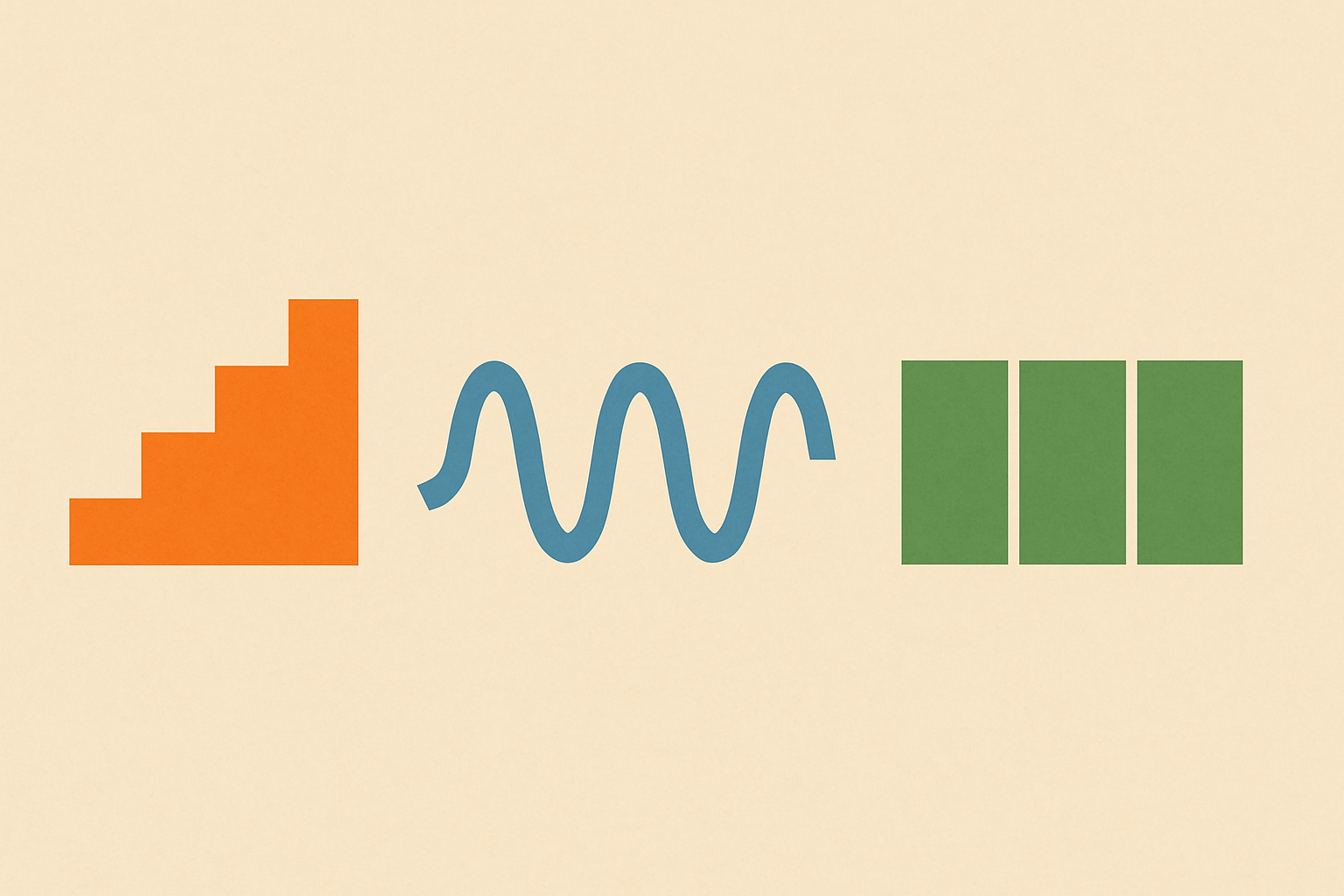Introduction: Powerful 12 Week Workout Program
A well-structured 12 week workout program provides the perfect framework for building total body strength, guiding you through progressive phases that challenge your body and mind. Whether you’re a seasoned lifter aiming to break through plateaus or a dedicated beginner ready to establish a solid foundation, this comprehensive guide will walk you through everything you need to maximize your results over the next three months. With science-backed techniques, smart programming, and expert strategies tailored to all fitness levels, this plan is your key to unlocking true physical transformation.
You may also like: The Ultimate 30-Day Workout Plan for Men Working Out in the Gym: Proven Full Body Strength Exercises to Maximize Results
Why Commit to a 12 Week Workout Program?
The commitment to a 12 week workout program is not just about hitting the gym—it’s about cultivating a lifestyle of discipline, self-awareness, and continual improvement. One of the primary benefits of such a program lies in its strategic duration. Twelve weeks is long enough to drive measurable, lasting results in both muscular development and overall health, yet short enough to maintain a high level of motivation and focus. This timeframe allows the body to adapt through distinct training phases, promoting sustained progress without burnout.
Furthermore, a well-designed 12 week strength training program supports neurological adaptation in the early weeks and gradually transitions into muscular hypertrophy and strength gains. By pacing the progression, trainees reduce the risk of injury while optimizing muscle recruitment and energy efficiency. The program’s predictability also enhances psychological commitment. Knowing what to expect in each phase increases compliance and reduces decision fatigue—a common hurdle for gym-goers unsure of what to do next.
Another key advantage is how this format integrates into goal-oriented fitness journeys. Whether preparing for a competition, overcoming a weight-loss plateau, or rebuilding post-injury, a 12 week fitness plan provides structure that allows for benchmarking and accountability. Most importantly, it transforms abstract fitness goals into tangible outcomes, making success not only possible but highly probable.
Building the Foundation: Phase 1 of the 12 Week Workout Plan
The first four weeks of any successful 12 week workout plan should emphasize foundational strength, movement efficiency, and exercise technique. This is the “preparatory” phase, where the primary objective is to build a solid base of muscular endurance, coordination, and joint integrity. Many injuries and plateaus stem from skipping this phase, as attempting heavy lifting without adequate groundwork often leads to compensation patterns and stress on vulnerable joints.
During this phase, compound movements like squats, lunges, push-ups, and rows take center stage. These exercises recruit multiple muscle groups, training the body as an integrated system rather than isolated parts. By focusing on these full-body patterns, participants learn to control their posture under load and activate deep stabilizing muscles essential for injury prevention. Core engagement and mobility work are also prioritized, ensuring optimal alignment and movement mechanics in later phases.
Another hallmark of this initial phase is tempo control. Slowing down repetitions improves time under tension and cultivates neuromuscular awareness. This controlled approach not only activates more muscle fibers but also reinforces proper form, laying the groundwork for intensity in the following phases. While weight selection may be moderate, the focus on execution and consistency builds a resilient body capable of withstanding the challenges to come.

Embracing Progressive Overload in the Middle Phase
As you transition into the second month of your 12 week exercise plan, your body is ready to handle greater demands. The middle phase, encompassing weeks five through eight, is where progressive overload becomes the guiding principle. Progressive overload refers to gradually increasing the challenge placed on your muscles over time, which is essential for strength development and muscle hypertrophy.
In this phase, workout intensity increases through heavier weights, additional sets, and shorter rest periods. The rep ranges begin to shift toward moderate zones—typically between 8 to 12 reps for hypertrophy and 4 to 8 reps for strength. This approach stimulates muscle protein synthesis while conditioning your central nervous system to tolerate and recover from higher intensities. During this stage, tracking your lifts becomes crucial. Monitoring your loads ensures consistent progression and helps identify plateaus before they stall your gains.
Another element introduced during this period is split training. While full-body workouts are common in Phase 1, this phase often adopts upper/lower or push/pull splits to increase volume without overtraining. These splits allow focused recovery for muscle groups and ensure each area is sufficiently challenged multiple times per week. Supplementing your strength work with active recovery days or light cardio also aids in nutrient delivery and metabolic health, keeping your body primed for performance.

The Final Push: Maximizing Results in Weeks 9 Through 12
In the last four weeks of the 12 week fitness plan, your focus shifts toward maximizing strength, refining muscular definition, and improving performance efficiency. This final phase consolidates the gains made in previous weeks while pushing your physical limits to peak capacity. It is in this stage that all the foundational work, strategic overload, and disciplined recovery come together to deliver visible, tangible results.
The training style here may involve lower rep ranges with maximal or near-maximal weights, often between 3 to 6 reps per set for primary lifts. Advanced techniques such as supersets, drop sets, and rest-pause training may be incorporated to further stimulate muscle fibers and elevate intensity. These methods challenge both your muscular and cardiovascular systems, promoting strength, endurance, and conditioning in a single session.
Recovery becomes even more vital during this period. To support continued adaptation, your program must account for adequate sleep, nutrition, and mobility work. Nutrient timing—particularly protein and carbohydrate intake post-workout—can enhance glycogen replenishment and muscle repair. Active recovery strategies like foam rolling, contrast therapy, and stretching also play a pivotal role in managing fatigue and preventing overuse injuries.
This final push is not only physical but also mental. By maintaining focus, discipline, and intention, you complete your 12 week workout program with a sense of accomplishment that extends beyond the mirror. It’s a testament to your growth—not just in strength, but in resilience, mindset, and commitment to self-improvement.

How to Customize a 12 Week Fitness Plan for Your Goals
While the structure of a 12 week strength training program provides a solid blueprint, individualization is the key to long-term success. No two bodies respond identically to training stimuli, and personal goals, fitness history, and preferences must be considered. Customizing your workout plan ensures you stay motivated and aligned with your unique vision of progress.
For those aiming for muscle gain, emphasizing hypertrophy-based training with moderate rep ranges and high training volume is critical. Exercises should include both compound lifts and targeted isolation movements, enabling maximal fiber recruitment and symmetry. Rest intervals should remain moderate, typically between 30 to 90 seconds, to sustain metabolic stress and anabolic signaling.
If fat loss is the goal, pairing resistance training with high-intensity interval cardio may yield optimal results. Integrating metabolic circuits or conditioning finishers at the end of strength workouts can accelerate calorie burn and elevate post-exercise oxygen consumption (EPOC). Nutritional strategies such as tracking caloric intake and focusing on whole, nutrient-dense foods further support a leaner physique without compromising muscle retention.
Athletes focused on performance may benefit from plyometrics, Olympic lifts, and speed drills integrated into their 12 week fitness plan for men or women. These elements develop power, coordination, and explosiveness—key components of athletic performance. Mobility and sport-specific movement patterns should also be emphasized to improve range of motion and functional transfer to game-day scenarios.
Nutrition and Recovery in Your 12 Week Strength Training Program
Strength gains aren’t made in the gym alone—they’re solidified through recovery and nutrition. A successful 12 week strength training program integrates fueling strategies that support muscle repair, hormone balance, and performance recovery. Without these elements, even the most well-structured program will fall short of its potential.
Protein intake is a foundational pillar for recovery. Consuming 1.6 to 2.2 grams of protein per kilogram of body weight per day supports muscle protein synthesis and mitigates breakdown, particularly during intense training phases. Quality sources such as lean meats, eggs, dairy, legumes, and whey protein powders ensure a diverse amino acid profile necessary for tissue repair and growth.
Carbohydrates are often misunderstood but remain essential for energy availability. Strength training depletes glycogen stores, and adequate carbohydrate intake restores them, enhancing training quality and recovery. Complex carbohydrates such as sweet potatoes, brown rice, and oats provide sustained energy while minimizing blood sugar spikes. Timing carbohydrate intake around workouts can further enhance performance and muscle fullness.
Equally critical is sleep. During deep sleep, growth hormone secretion peaks, facilitating tissue regeneration and cognitive restoration. Aiming for 7 to 9 hours of quality sleep each night ensures optimal hormonal regulation, focus, and motivation. Complementing sleep with active recovery practices, hydration, and stress management rounds out the recovery toolkit, enabling consistent progression throughout your 12 week workout plan.

Adapting the 12 Week Workout Plan for Men and Women
While the foundational principles of a 12 week workout plan for men and women remain consistent—progressive overload, recovery, and structured programming—there are physiological and hormonal differences that may warrant adaptations for each gender. Understanding these distinctions ensures that the plan respects individual needs while still driving optimal results.
For men, the presence of higher testosterone levels often translates to greater potential for muscular hypertrophy and strength development. As a result, men may respond well to slightly higher training volumes and heavier compound lifts, particularly when focusing on upper body development. Exercises like bench presses, overhead presses, and weighted chin-ups can be emphasized alongside leg training to achieve balanced muscularity. Additionally, shorter rest periods between hypertrophy sets may suit men due to enhanced recovery speed during moderate training phases.
In contrast, women tend to exhibit greater muscular endurance and recover faster between sets, especially for lower body movements. This makes them well-suited for higher repetition ranges and greater training frequency. The inclusion of hip thrusts, Bulgarian split squats, and glute bridges aligns with common training goals for women while also strengthening the posterior chain. Contrary to popular belief, resistance training does not lead to bulky physiques for women. Rather, it fosters lean muscle mass, improved metabolism, and enhanced definition.
Hormonal cycles may also influence training adaptation. Women may benefit from deloading or modifying intensity during phases of their menstrual cycle when energy levels and recovery capacity fluctuate. Listening to the body’s cues and adjusting workload accordingly promotes sustainability and long-term adherence. Whether male or female, the 12 week fitness plan should serve as a flexible framework—one that encourages autonomy, personalization, and empowerment.

Periodization Strategies in the 12 Week Exercise Plan
The concept of periodization is central to maximizing the effectiveness of a 12 week exercise plan. Periodization refers to the systematic planning of training variables—intensity, volume, frequency, and rest—to optimize physical adaptation while minimizing the risk of overtraining or stagnation. By organizing the program into distinct training blocks, individuals can strategically stimulate growth while preserving recovery.
Linear periodization is one common model, where training progresses from higher volume and lower intensity to lower volume and higher intensity over the 12 weeks. This method is ideal for beginners and intermediate lifters seeking a straightforward progression toward strength. For example, an individual may begin with sets of 12 to 15 reps at 60% of their one-rep max and conclude the program with sets of 3 to 5 reps at 85–90% intensity.
Undulating periodization offers more variation by fluctuating volume and intensity on a weekly or even daily basis. This method may be better suited for advanced lifters who require more nuanced stimuli to continue progressing. A sample week might alternate between hypertrophy, strength, and power sessions, creating diverse demands that challenge the body in multiple dimensions.
Block periodization is another effective strategy, particularly for athletes. Each 4-week block targets a specific quality—such as endurance, hypertrophy, or power—before transitioning to the next. This format allows for highly focused adaptations and is often used in conjunction with performance benchmarks or competition dates.
Whichever model is selected, the goal of periodization is to prevent training monotony, optimize physiological adaptation, and maintain momentum throughout the program. A well-periodized 12 week workout program evolves as you do, meeting you at your current capacity while pushing you toward your potential.

Tracking Progress for Long-Term Success
Success in any 12 week workout program is not solely measured by the number on the scale or the weight on the barbell. It’s about tracking meaningful progress across multiple dimensions of fitness, performance, and well-being. Establishing measurable benchmarks at the outset of the program allows you to evaluate progress with clarity and adjust your approach as needed.
Strength metrics are a common starting point. Recording your maximum or working weights in key lifts—such as the squat, deadlift, and bench press—provides a tangible marker of improvement. Repetition maximums (e.g., 5RM, 10RM) and total volume (sets × reps × load) also offer valuable insights into training efficiency and capacity.
Body composition measurements, including waist circumference, body fat percentage, or progress photos, help visualize changes in muscle definition and fat loss over time. These metrics often reveal improvements not reflected by the scale alone, especially when muscle gain offsets fat loss. Consistent timing and methodology when tracking these changes (e.g., same lighting, same time of day) increase accuracy and reliability.
Equally important are subjective markers. How do you feel during workouts? Are you sleeping better, recovering faster, or experiencing less joint pain? Enhanced energy levels, improved mood, and better stress tolerance are all signs that your 12 week fitness plan is enhancing overall health—not just physique. Keeping a training journal or digital log fosters reflection and accountability, making each session a data point in your larger transformation journey.
Avoiding Plateaus and Staying Motivated
Even the most meticulously designed 12 week workout plan can encounter plateaus—periods where progress stalls despite consistent effort. These moments, though frustrating, are not signs of failure but opportunities for adjustment and growth. Recognizing the causes of plateaus and addressing them strategically ensures that momentum is maintained throughout the program.
One of the most common culprits is adaptation. As the body becomes more efficient at performing certain exercises, the stimulus they provide diminishes. To combat this, subtle changes such as altering grip width, changing rest periods, or rotating exercise order can reignite adaptation. Deload weeks—planned reductions in training intensity or volume—also allow the body to recover and prime itself for the next performance leap.
Overtraining is another plateau trigger. When recovery doesn’t match training intensity, performance can decline, and motivation may wane. Symptoms such as persistent fatigue, decreased strength, irritability, or disrupted sleep warrant immediate attention. Prioritizing rest, nutrition, and stress reduction can restore balance and reignite enthusiasm.
Mental fatigue, too, can erode commitment. Maintaining motivation often requires reconnecting with your “why”—the intrinsic reason you began the 12 week workout program. Whether it’s personal empowerment, health improvement, or performance goals, keeping that purpose front of mind fuels discipline when willpower falters. Celebrating small wins and surrounding yourself with a supportive community enhances accountability and joy, transforming the journey from obligation to empowerment.

Integrating the 12 Week Workout Program into a Lifelong Fitness Habit
Although a 12 week workout program is time-bound, its value extends far beyond the final session. What begins as a structured fitness initiative can become the foundation of a lifelong habit—one that empowers you to live with vitality, confidence, and purpose. By viewing the program not as an endpoint but a launchpad, you build a sustainable relationship with movement and wellness.
Post-program planning is key. Reflecting on what worked, what challenged you, and what you enjoyed helps shape your next steps. Perhaps you discovered a passion for powerlifting, a renewed love for running, or a desire to master calisthenics. Translating these insights into future training goals maintains continuity and fuels growth.
Equally important is the mindset shift from temporary effort to enduring identity. Instead of thinking, “I followed a program,” you begin to think, “I am someone who trains consistently and prioritizes health.” This identity anchors behaviors even when motivation fluctuates. Consistency, not perfection, becomes the cornerstone of your fitness journey.
Incorporating variety and autonomy also nurtures adherence. Exploring new activities, joining fitness classes, or training with friends keeps workouts exciting and socially enriching. Periodically returning to a 12 week strength training program—refined and updated—provides structure while honoring your evolution. With each cycle, you deepen your understanding of your body and expand your capabilities.
Frequently Asked Questions About the 12 Week Workout Program for Total Body Strength
1. How can a 12 week workout program reshape your mindset toward long-term fitness?
One of the most overlooked benefits of a 12 week workout program is the psychological transformation it can trigger. By committing to a structured routine over three months, individuals often shift from viewing exercise as a short-term obligation to embracing it as a lifelong discipline. This mindset change fosters internal motivation, as progress becomes a personal narrative rather than an external expectation. Moreover, seeing tangible improvements in strength, mobility, or endurance provides emotional reinforcement that builds confidence far beyond the gym. A well-executed 12 week fitness plan not only builds your body—it reprograms your relationship with consistency, accountability, and self-worth.
2. What are the most common mistakes people make during a 12 week strength training program?
Many people begin a 12 week strength training program with high enthusiasm but underestimate the importance of recovery, progression pacing, and exercise form. Overtraining in the early weeks can lead to fatigue, injury, or mental burnout by the halfway point. Others stagnate by failing to apply the principle of progressive overload—either not increasing resistance or reps when adaptation occurs. Neglecting proper warm-ups, mobility work, and sleep can silently sabotage results, no matter how well-designed the 12 week exercise plan is. Additionally, poor nutritional support—such as inconsistent protein intake or under-eating—can severely limit muscle gain. Building awareness of these pitfalls before starting a 12 week workout plan is crucial for maximizing results safely.
3. How do hormonal changes influence results in a 12 week fitness plan for men?
Men following a 12 week fitness plan often experience a surge in hormonal optimization, especially if strength training and adequate rest are prioritized. Testosterone levels can increase naturally through resistance training, improving muscle synthesis, fat metabolism, and motivation. Cortisol, the primary stress hormone, can be better regulated with proper sleep and balanced intensity levels. In some men, growth hormone secretion also improves during deep sleep phases triggered by physical exertion. A well-structured 12 week workout program encourages these hormonal shifts in a balanced, sustainable way, which is especially impactful for men over 30 dealing with natural hormonal decline.
4. What are some advanced techniques to break through plateaus in a 12 week workout plan?
For experienced individuals, plateaus during a 12 week workout plan are common, especially around weeks 6 to 8. To break through these sticking points, advanced methods such as tempo training, supersets, and rest-pause sets can be introduced. Periodization models—where you manipulate intensity, volume, and frequency weekly—can prevent adaptation and enhance neuro-muscular performance. Including mobility circuits, corrective drills, or even contrast training can reinvigorate stale routines. Even psychological tactics like visualization, mindfulness-based breathing, or journaling can renew focus and prevent mental fatigue during the final stretch of the 12 week strength training program.
5. Why is lifestyle integration critical for the success of any 12 week fitness plan?
A 12 week fitness plan is only as effective as your ability to weave it into your broader lifestyle. Work stress, irregular sleep, travel, or poor nutrition can all interfere with training adherence and recovery. Success depends on creating routines that harmonize with your professional and personal responsibilities—like scheduling workouts at consistent times, batch-preparing meals, and setting digital reminders. Partnering with a friend or coach can also boost accountability. Long-term transformation stems from the seamless integration of your 12 week workout program into daily habits, rather than treating it as a standalone event.
6. What role does recovery play in maximizing results from a 12 week workout program?
Recovery is the silent driver of progress in any 12 week workout program. Without it, even the most scientifically structured training plan will stall. High-intensity workouts break down muscle tissue, and it’s during sleep and rest that the body rebuilds stronger fibers. Delayed onset muscle soreness (DOMS), reduced performance, and mood imbalances are early signs of inadequate recovery. Including active rest days, cold therapy, massage, or even yoga into a 12 week workout plan for men can dramatically improve resilience and longevity. Monitoring heart rate variability (HRV) or resting heart rate can also help gauge when more recovery is needed.
7. How does a 12 week exercise plan impact long-term metabolic health?
Beyond aesthetics or performance, a well-structured 12 week exercise plan has profound benefits on metabolic health. Consistent strength and cardio training enhances insulin sensitivity, reduces triglyceride levels, and promotes more efficient glucose metabolism. Muscle mass acts as a metabolic furnace, helping regulate blood sugar levels and decrease fat storage, especially around the abdomen. Studies show that even three months of targeted training can significantly reduce risk markers for type 2 diabetes and cardiovascular disease. Integrating strength training with compound movements into your 12 week workout program ensures these health gains persist beyond the plan’s duration.
8. What makes a 12 week workout plan for men uniquely effective compared to shorter plans?
A 12 week workout plan for men offers a unique balance between depth and duration—long enough to enable muscle adaptation but short enough to maintain high motivation. Men typically respond well to structured, periodized routines that focus on progressive overload, recovery, and mobility. Unlike 4- or 6-week programs, a 12 week strength training program provides time to develop technique, mental discipline, and joint resilience. It also allows for cyclical variation, meaning men can emphasize different fitness qualities—strength, hypertrophy, and endurance—within a single macrocycle. This comprehensive design ensures results that aren’t just fast, but also sustainable.
9. How can nutrition be personalized during a 12 week workout program for better outcomes?
Generic meal plans often fall short during a 12 week workout program because individual needs vary based on goals, body composition, and training intensity. For strength-focused routines, increasing protein intake to 1.6–2.2 grams per kilogram of body weight can aid muscle repair. Those aiming for fat loss might use a slight calorie deficit while ensuring nutrient timing—like post-workout carbohydrate intake—is optimized. Hydration, micronutrient sufficiency, and even gut health are often overlooked but vital. Periodic re-evaluation of dietary choices ensures your 12 week fitness plan aligns with shifting performance and body composition changes across the 12-week timeline.
10. What should you do after completing a 12 week workout program to maintain progress?
The end of a 12 week workout program should not signal the end of your training journey—it’s a launchpad for the next phase. Many fall into the trap of losing momentum after the structure is gone. Transitioning to a maintenance or advanced routine based on your new fitness level is key. Reflect on what worked well, what challenged you, and where growth opportunities lie. Consider incorporating deload weeks, exploring new training styles like CrossFit or Olympic lifting, or revisiting your 12 week fitness plan with progressive modifications. This period is also ideal for setting new performance goals to sustain motivation and drive.
Conclusion: Elevate Your Fitness Journey with a 12 Week Workout Program
Embarking on a 12 week workout program is more than a physical commitment—it is a declaration of your willingness to evolve, challenge your limits, and invest in a stronger, more resilient version of yourself. Through carefully structured phases, personalized programming, and evidence-based strategies, you cultivate not just total body strength, but mental toughness and discipline that transcend the gym.
This transformative process begins with foundational movements and builds through progressive overload, strategic periodization, and tailored nutrition. It culminates in a body and mindset that reflect your effort, resilience, and growth. Whether you’re following a 12 week fitness plan for men, adapting it for female physiology, or customizing it for your unique goals, the principles remain the same: consistency, intentionality, and self-awareness.
More importantly, the end of the program is not a finish line—it’s a milestone on your lifelong path to wellness. The habits, insights, and confidence you gain become the tools you carry forward, guiding your choices and sustaining your momentum. In a world of quick fixes and fleeting trends, a 12 week workout plan offers something far more valuable: a blueprint for lasting transformation and empowered living.
So take the first step. Commit to the journey. And let your strength, determination, and vision redefine what’s possible—one rep, one session, and one week at a time.





